Final Fantasy 7 Rebirth may have the best version of gaming’s most beloved flashback – final hands-on preview
One Final Fantasy's most iconic moments gets a rethink in Final Fantasy 7 Rebirth – and it's absolutely worth seeing for yourself.
There are few individual sequences in video game history that are as famed - and as important - as Final Fantasy 7’s ‘Nibelheim Flashback’. When you think about what this sequence accomplishes, it’s pretty heady. It sets up the stakes of FF7’s genre-defining narrative, solidifies an all-time iconic villain, has some incredible technological execution (for the time), and also creates one of the most enduring single images in gaming history. Basically, it’s important.
That makes Final Fantasy 7 Rebirth’s task of rebuilding the scene for the modern age difficult. But it’s made more complicated still by the fact ‘The Nibelheim Incident’ has been done more than once - and honestly, always pretty well.
There’s the original Final Fantasy 7 (1997), then there’s anime Last Order (2005), and beloved spin-off Crisis Core (2007). All have slightly different versions of the events, each slightly unique, each another layer to the story even as they lightly contradict each other. Then there’s other variations - an alternate angle on events featured in Japan-only mobile game Before Crisis (2004), and it’s also recently appeared in Ever Crisis (2023). This is well-trodden ground.
.png?width=690&quality=70&format=jpg&auto=webp)
While players will be able to experience a demo that showcases a slice of the Nibelheim flashback (around a third of it) now, I got to go hands-on with the sequence in full as part of FF7 Rebirth’s final hands-on event. While I got to also experience more of the game’s open-world ambitions, I don’t have too much new to say there than I said back in September, as a Final Fantasy lore goblin it was inevitably the flashback that grabbed my attention the most.
In honesty, gameplay-wise this is similar enough to many of the rollercoaster mission sequences of FF7 Remake. You’re drawn from one combat encounter to another, dynamic music stringing you along by dipping from the frenzied beats of combat to a calmer but still tense thrum between encounters. Every now and then, the cadence is broken up by a cutscene or a small busywork puzzle, like hoovering up leaking Mako to make an area safe. Then you move on.
All of that is sort-of as expected. My anticipation is that Rebirth will be a bigger, better, more bombastic version of Remake, and also have the courage to stray even further from the source material. But there are places where Rebirth surprises, nevertheless.
.png?width=690&quality=70&format=jpg&auto=webp)
It’s mostly in story execution, really. For my money, the original flashback is defined by a characterful slow-burn introduction as Cloud and company arrive at Nibelheim and get to know the town. I was concerned that might not be so here, as the flashback forms one of the earliest parts of Rebirth. In fact, the preview build makes clear that it is ‘Chapter 1’. But the remade version of the flashback doesn’t swap this out for an action-packed intro: you get a chance to noodle around the town, and are actively encouraged to do things like explore Tifa’s house and reunite with Cloud’s mother - all as the tension and dread builds for what is to come.
Part of this, I suspect, is bravery. Another part is likely a clever bit of misdirection, as the build we played lacked a clear ‘opening’ to the game - suggestive, to me at least, that this Chapter 1 introduction actually follows something else that has a bit of the bombast of the Bombing Mission - probably something involving Zack.
Either way, it works because it retains and actually enhances what made the original flashback so effective. Small details, like playing Tifa’s piano, are now full-blown mini-games. Blink-and-you’ll-miss-it irrelevant characters from the original are now given some detail beyond being a mere sketch of a person, and so on.
Somehow, this version of this classic scene threads the needle. It offers something new in terms of the depth of the characterization of both Cloud and Sephiroth, the two key players in events. It has a flair for the cinematic, and a devoted adoration for the source material. It just works.
.png?width=690&quality=70&format=jpg&auto=webp)
It even works in spite of a handful of obvious flaws. Any time FF7 Remake tried to shoot for Uncharted-style in-game drama it fell a bit flat - and here, as Cloud hobbles around a burning Nibelheim at ultra-low speed with visual design that doesn’t make it entirely initially clear where in the flames you’re meant to be going, I wince.
As I’m asked to squeeze down one trigger after another to make him crawl along the floor, injured, I am reminded of Tifa’s mega-crap ‘Baby’s first Tomb Raider’ sequence from FF7 Remake, and vaguely annoyed. Generally speaking, I look at this stuff and think ‘this is lame, it should’ve just been a cutscene’ – a thought that comes naturally, given how lavish and wonderful FF7 Rebirth’s hand-directed cutscenes are.
This is perhaps demonstrative of how, even if FF7 Rebirth is bigger and better, it might still be guilty of some of the worst proclivities of its predecessor. But you know what? I really don’t care. It still feels like the best-ever version of one of the most important sequences in gaming history - and that speaks to the quality of what’s on offer, and the deft hand of the developers behind it. Now all we have to do is wait and see if the rest of the game can live up to that. If it can, it could very well be an all-time classic.
Final Fantasy 7 Rebirth is due to release February 29, on PS5.





.jpg?width=291&height=164&fit=crop&quality=80&format=jpg&auto=webp)

.jpg?width=291&height=164&fit=crop&quality=80&format=jpg&auto=webp)
